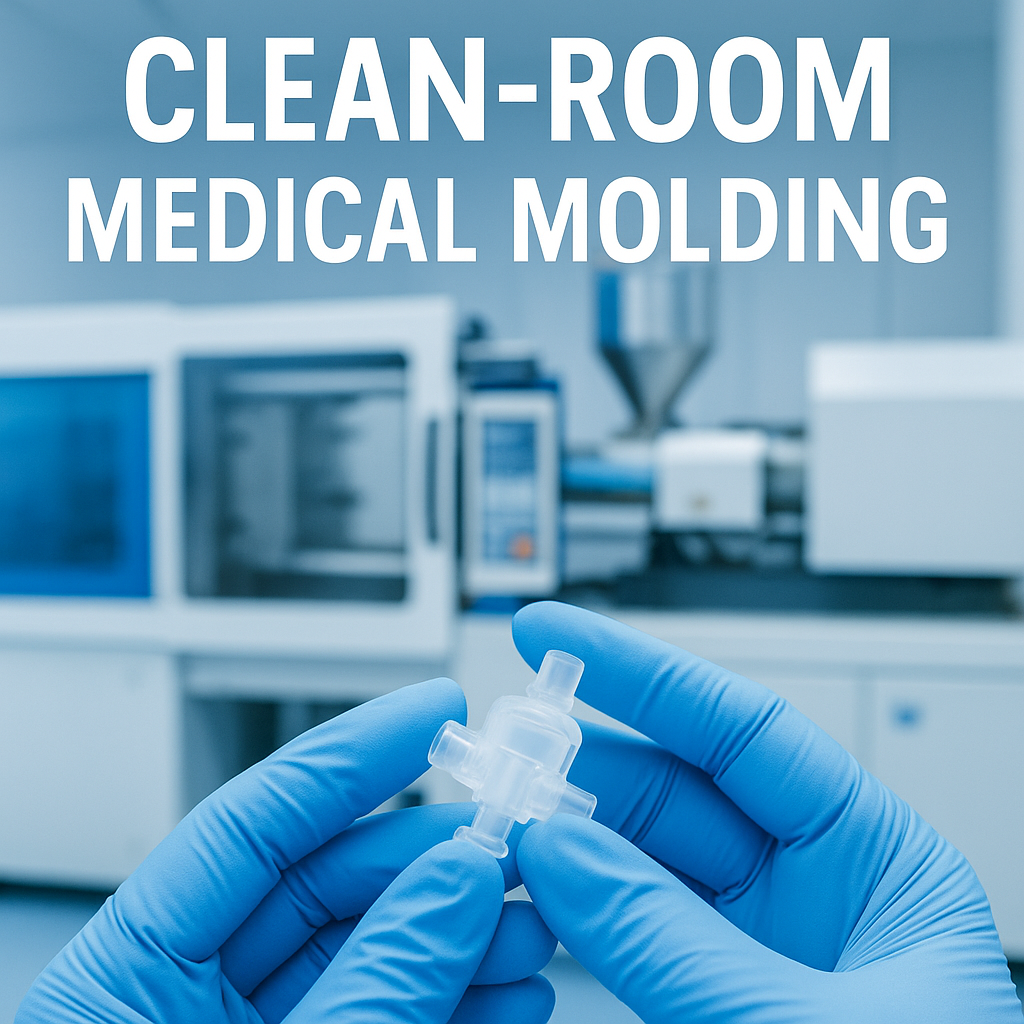Implement Medical & Clean-Room Injection Molding for High-Purity Applications
Implement Medical & Clean-Room Injection Molding for High-Purity Applications
When plastics enter contact with blood, pharmaceuticals, or sensitive micro-electronic chemistries, even a few stray particles, trace oils, or bioburden can jeopardize patient safety or destroy product yield. Medical-grade molding performed inside clean-room environments eliminates these risks by combining biocompatible polymers, ISO-certified quality systems, and ultra-clean manufacturing controls. Below is a practical roadmap—design through validation—for engineers, buyers, and quality managers who need to deliver zero-defect, contaminant-free components at scale.
1. Clean-Room Injection Molding at a Glance
| Element | Requirement | Typical Medical Spec |
|---|---|---|
| Clean-Room Class | ISO 14644-1 airborne particulate limits | Class 7 or 8 for molded parts; Class 5–6 for aseptic assembly |
| Quality System | ISO 13485:2016 or 21 CFR 820 (FDA QSR) | Ensures traceability, CAPA & device-history records |
| Materials | USP Class VI, ISO 10993, DIN EN ISO 11607 certified resins | PC, PP, PEI, POM, TPE, COC, PEEK |
| Validation | IQ → OQ → PQ with CpK ≥ 1.67 on CTQs | Locks process window & documents reproducibility |
| Sterilization Compatibility | EtO, Gamma, e-Beam, Autoclave | Confirm with resin supplier & in-house dosimetry |
2. Facility & Equipment Essentials
-
Press Configuration
-
All-electric or hybrid machines with closed-loop servo drives minimize hydraulic oil migration.
-
Stainless-steel guarding and smooth, powder-coated surfaces ease sanitization.
-
-
Material Handling
-
Closed conveying and dessicant dryers plumbed directly to the press throat.
-
Colorants stored in double bags; additives weighed inside laminar-flow hoods.
-
-
Mold Design for Cleanliness
-
Self-draining water circuits to avoid stagnant pools (bacteria growth).
-
Evacuation vents/pins designed for easy disassembly and ultrasonic cleaning.
-
Cavity steel choices—S136, H13, or NAK-80—for corrosion resistance to disinfectants.
-
-
Automation & Packaging
-
Class-compatible pick-and-place robots deposit parts onto sterile trays.
-
Inline vision inspection rejects flash/kiss and confirms gate vestige length.
-
3. Design Guidelines for High-Purity Components
| Feature | Recommendation | Rationale |
|---|---|---|
| Draft Angles | ≥ 1° on polished faces | Aids clean release, reduces scuff particles |
| Wall Uniformity | ± 15 % | Prevents voids that can trap sterilant residues |
| Internal Corners | Radii ≥ 0.25 mm | Eliminates micron “dead zones” for microbes |
| Text & Logos | Debossed, polished | Minimizes dust-catching edges |
| UDI Marking Area | Flat, non-textured land | Guarantees laser contrast without burn marks |
4. Material Selection Matrix
| Resin | Key Attributes | Typical High-Purity Uses |
|---|---|---|
| COC/COP | Glass-like clarity, low extractables | Micro-fluidic chips, diagnostic cuvettes |
| Medical-Grade PC | Tough, gamma stable | Blood-oxygenator housings, syringe barrels |
| PEEK | 250 °C HDT, steam-sterilizable | Surgical tools, dental implant guides |
| TPE (Class VI) | Soft, PVC-free | Catheter balloons, seals, over-molded grips |
| High-Purity PP | Chemical resistance, low cost | IV bottle closures, Luer connectors |
Always demand a full ISO 10993 biological evaluation summary and Certificates of Analysis (CoA) for each lot.
5. Step-by-Step Validation Framework
| Phase | Objective | Typical Deliverables |
|---|---|---|
| IQ – Installation Qualification | Confirm equipment & utilities meet spec | Calibration certificates, mold inspection report |
| OQ – Operational Qualification | Establish critical limits | DOE matrix, alarm band settings, µ-level particle counts |
| PQ – Performance Qualification | Demonstrate reproducible production | Three consecutive lots; 100 % dimensional & bioburden pass |
Tip: Install cavity-pressure sensors as surrogate CTQs; they correlate directly to fill balance and part weight stability.
6. Risk-Reduction Best Practices
-
Pre-Sterilization Bioburden Test – Sample every 10 k shots to monitor microbial load drift.
-
Operator Gowning Audits – Weekly, unannounced compliance checks; capture in QMS.
-
Resin Lot Segregation – Color-coded hoppers and RFID tagging avoid cross-contamination.
-
Environmental Monitoring – HEPA integrity, airflow, and surface swabs logged per shift.
-
Tool Preventive Maintenance – Cleanroom-approved lubricants; detailed PM after set cycle counts.
7. Why TaiwanMoldMaker.com for Medical & Clean-Room Projects?
-
ISO 7 & ISO 8 Molding Suites – Integrated with automated take-out, vision inspection, and Class 5 assembly cells.
-
On-Site Sterilization Partners – Gamma, e-Beam, and EtO services plus dose audits in < 48 h.
-
Regulatory Documentation Ready – IQ/OQ/PQ templates, process FMEA, and PSUR support for MDR.
-
Fast Material Access – Local inventory of medical-grade PC, PP, COC, PEEK; samples molded in < 1 week.
-
English-Fluent Engineering – Real-time DFM sessions, eDart data sharing, and 24/6 support across time zones.
8. Action Plan—Launch Your High-Purity Part
-
Define Sterilization & Biocompatibility Targets (EtO, Gamma, Steam; ISO 10993 tests).
-
Upload CAD & CTQ List to TaiwanMoldMaker.com for a 48-hour clean-room DFM review.
-
Approve Tool Concept & Validation Schedule – with cavity sensors and particle-count KPIs.
-
Execute IQ/OQ/PQ – Receive full electronic Device-History Record package.
-
Scale to Volume – VMI or just-in-sequence assembly direct from clean-room packaging.
Ready to Protect Purity & Precision?
Submit your project details to TaiwanMoldMaker.com and connect with clean-room molding specialists who combine scientific molding, rigorous quality systems, and regulatory know-how—ensuring every critical component meets the highest purity and precision standards.









